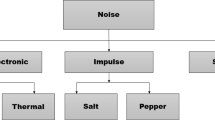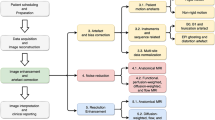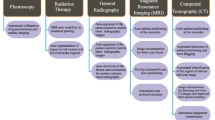Abstract
Cone beam computed tomography (CBCT) is an important tool for clinical diagnosis and many industrial applications. However, ring artifacts usually appear in CBCT images, due to device responding inconsistence. This paper designs a generative adversarial network (GAN) to remove ring artifacts and meanwhile to retain important texture details in CBCT images. This method firstly transforms ring artifacts in Cartesian coordinates to stripe artifacts in polar coordinates, which is very helpful for removing ring artifacts. Then, we design a new loss function for GAN, including three parts: unidirectional relative total variation loss, perceptual loss and adversarial loss. Further, inspired by super-resolution generative adversarial networks, we use very deep residual networks for both generator and discriminator. Experimental results show that the proposed method is more effective for ring artifacts removal, compared to our baseline and some traditional methods.










Similar content being viewed by others
References
Fox EC, Nixon O, Agwani MS, Dykaar DR, Mantell TJ, Sabila RW (1998) High-speed linear CCD sensor with pinned photodiode photosite for low-lag and low-noise imaging. In: Solid state sensor arrays: development and applications II, vol 3301, pp 17–27, International Society for Optics and Photonics
Seibert JA, Boone JM (2015) Flat-field correction technique for digital detectors. In: Proceedings of SPIE, vol 3336, pp 348–354
Liang Lihong L H (2004) The corrected research of flat-panel detector imaging system. Acta Photonica Sin 33(10):1277–1280
Jiang XG, Zhang KZ, Li CG, Wang Y (2007) Extended applications of image flat-field correction method. Acta Photonica Sin 36(9):1587–1590
Tang X, Ning R, Yu R, Conover D (2001) Cone beam volume CT image artifacts caused by defective cells in X-ray flat panel imagers and the artifact removal using a wavelet-analysis-based algorithm. Med Phys 28(5):812–825
Kowalski G (1978) Suppression of ring artefacts in CT fan-beam scanners. IEEE Trans Nucl Sci 25(5):1111–1116
Raven C (1998) Numerical removal of ring artifacts in microtomography. Rev Sci Instrum 69(8):2978–2980
Münch B, Trtik P, Marone F, Stampanoni M (2009) Stripe and ring artifact removal with combined wavelet fourier filtering. Opt Express 17(10):8567–8591
Haibel A, Boin M (2006) Compensation of ring artefacts in synchrotron tomographic images. Opt Express 14(25):12071–12075
Ashrafuzzaman ANM, Lee SY, Hasan MK (2011) A self-adaptive approach for the detection and correction of stripes in the sinogram: suppression of ring artifacts in CT imaging. Eurasip J Adv Signal Process 2011(1):1–13
Titarenko S, Titarenko V, Kyrieleis A, Withers PJ, Carlo FD (2011) Suppression of ring artefacts when tomographing anisotropically attenuating samples. J Synchrotron Radiat 18(3):427–435
Miqueles EX, Rinkel J, O’Dowd F, Bermdez JSV (2014) Generalized Titarenko’s algorithm for ring artefacts reduction. J Synchrotron Radiat 21(6):1333–1346
Titarenko V (2016) Analytical formula for two-dimensional ring artefact suppression. J Synchrotron Radiat 23(6):1447–1461
Mohan KA, Venkatakrishnan SV, Drummy LF, Simmons J (2014) Model-based iterative reconstruction for synchrotron X-ray tomography. In: IEEE international conference on acoustics, speech and signal processing, pp 6909–6913
Pierre P, Alessandro M (2015) Ring artifacts correction in compressed sensing tomographic reconstruction. J Synchrotron Radiat 22(Pt 5):1268–1278
Kyriakou Y, Prell D, Kalender WA (2009) Ring artifact correction for high-resolution micro CT. Phys Med Biol 54(17):N385
Prell D, Kyriakou YKalender W A (2009) Comparison of ring artifact correction methods for flat-detector CT. Phys Med Biol 54(12):3881
Chen YW, Duan G, Fujita A, Hirooka K, Ueno Y (2009) Ring artifacts reduction in cone-beam CT images based on independent component analysis. In: Instrumentation and measurement technology conference, 2009. I2MTC ’09. IEEE, pp 1734–1737
Chen YW, Duan G (2009) Independent component analysis based ring artifact reduction in cone-beam CT images. In: IEEE international conference on image processing, pp 4137–4140
Yan L, Wu T, Zhong S, Zhang Q (2016) A variation-based ring artifact correction method with sparse constraint for flat-detector CT. Phys Med Biol 61(3):1278
Sijbers J, Postnov A (2004) Reduction of ring artefacts in high resolution micro-CT reconstructions. Phys Med Biol 49(14):N247
Brun F, Kourousias G, Dreossi D, Mancini L (2009) An improved method for ring artifacts removing in reconstructed tomographic images. Springer, Berlin
Wei Z, Wiebe S, Chapman D (2013) Ring artifacts removal from synchrotron CT image slices. J Instrum 8(6):C06006
Bouali M, Ladjal S (2011) Toward optimal destriping of modis data using a unidirectional variational model. IEEE Trans Geosci Remote Sens 49(8):2924–2935
Xu L, Yan Q, Xia Y, Jia J (2012) Structure extraction from texture via relative total variation. ACM Trans Graph 31(6):139
Green M, Marom EM, Kiryati N, Konen E, Mayer A (2016) Efficient low-dose CT denoising by locally-consistent non-local means (LC-NLM). In: International conference on medical image computing and computer-assisted intervention, pp 423–431, Springer
Liu Y, Zhang Y (2018) Low-dose CT restoration via stacked sparse denoising autoencoders. Neurocomputing 284:80–89
Ronneberger O (2017) Invited talk: U-Net convolutional networks for biomedical image segmentation. In: Bildverarbeitung für die Medizin 2017, p 3, Springer
Deng Y, Bao F, Deng X, Wang R, Dai Q (2016) Deep and structured robust information theoretic learning for image analysis. IEEE Trans Image Process 25:4209–4221
He K, Zhang X, Ren S, Sun J (2016) Deep residual learning for image recognition. In: Proceedings of the IEEE conference on computer vision and pattern recognition, pp 770–778
Deng Y, Ren Z, Kong Y, Bao F, Dai Q (2017) A hierarchical fused fuzzy deep neural network for data classification. IEEE Trans Fuzzy Syst 25(4):1006–1012
Ledig C, Theis L, Huszar F, Caballero J, Cunningham A, Acosta A, Aitken A, Tejani A, Totz J, Wang Z et al (2017) Photo-realistic single image super-resolution using a generative adversarial network, In: Proceedings of the IEEE conference on computer vision and pattern recognition, pp 4681–4690
Gulrajani I, Ahmed F, Arjovsky M, Dumoulin V, Courville AC (2017) Improved training of Wasserstein GANs. In: International conference on neural information processing systems, pp 5769–5779
Ji Y, Zhang H, Wu QJ (2018) Saliency detection via conditional adversarial image-to-image network. Neurocomputing 316:357–368
Zhang H, Sun Y, Liu L, Wang X, Li L, Liu W (2018) ClothingOut: a category-supervised GAN model for clothing segmentation and retrieval. Neural Comput Appl. https://doi.org/10.1007/s00521-018-3691-y
Brock A, Lim T, Ritchie JM, Weston N (2016) Neural photo editing with introspective adversarial networks. ArXiv preprint arXiv:1609.07093
Deng Y, Shen Y, Jin H (2017) Disguise adversarial networks for click-through rate prediction. In: Proceedings of the 26th international joint conference on artificial intelligence, AAAI Press, pp 1589-1595
Deng Y, Chen KW, Shen Y, Jin H (2018) Adversarial active learning for sequences labeling and generation. In: Proceedings of the twenty-seventh international joint conference on artificial intelligence, pp 4012–4018, International Joint Conferences on Artificial Intelligence Organization
Simonyan K, Zisserman A (2014) Very deep convolutional networks for large-scale image recognition. ArXiv preprint arXiv:1409.1556
Yang Q, Yan P, Zhang Y, Yu H, Shi Y, Mou X, Kalra MK, Zhang Y, Sun L, Wang G (2017) Low dose CT image denoising using a generative adversarial network with Wasserstein distance and perceptual loss. IEEE Trans Med Imaging PP(99):1–1
Zhang H, Sindagi V, Patel VM (2017) Image de-raining using a conditional generative adversarial network. ArXiv preprint arXiv:1701.05957
Kupyn O, Budzan V, Mykhailych M, Mishkin D, Matas J (2017) Deblurgan: blind motion deblurring using conditional adversarial networks. ArXiv preprint arXiv:1711.07064
Goodfellow IJ, Pouget-Abadie J, Mirza M, Xu B, Warde-Farley D, Ozair S, Courville A, Bengio Y (2014) Generative adversarial nets. In: International conference on neural information processing systems, pp 2672–2680
Creswell A, White T, Dumoulin V, Kai A, Sengupta B, Bharath AA (2018) Generative adversarial networks: an overview. IEEE Sig Process Mag 35(1):53–65
Li J, J-h Cheng, J-y Shi, Huang F (2012) Brief introduction of back propagation (BP) neural network algorithm and its improvement. In: Jin D, Lin S (eds) Advances in computer science and information engineering. Springer, Berlin, pp 553–558
Gribbon KT, Bailey DG (2004) A novel approach to real-time bilinear interpolation. In: IEEE international conference on field-programmable technology, pp 126–131
Huo Q, Li J, Lu Y (2016) Removing ring artefacts in CT images via unidirectional relative variation model. Electron Lett 52(22):1838–1839
Dong C, Loy CC, He K, Tang X (2016) Image super-resolution using deep convolutional networks. IEEE Trans Pattern Anal Mach Intell 38(2):295–307
Shi W, Caballero J, Huszár F, Totz J, Aitken AP, Bishop R, Rueckert D, Wang Z (2016) Real-time single image and video super-resolution using an efficient sub-pixel convolutional neural network. In: Proceedings of the IEEE conference on computer vision and pattern recognition, pp 1874–1883
Johnson J, Alahi A, Li FF (2016) Perceptual losses for real-time style transfer and super-resolution. In: European conference on computer vision, pp 694–711
Bruna J, Sprechmann P, LeCun Y (2015) Super-resolution with deep convolutional sufficient statistics. ArXiv preprint arXiv:1511.05666
Kingma DP, Ba J (2014) Adam: a method for stochastic optimization. ArXiv preprint arXiv:1412.6980
Acknowledgements
This work was supported by the National Natural Science Foundation of China (No. 61271374). The authors would like thank the anonymous reviews for their helpful suggestions which have led to great improvement on this paper, especially on the experiments.
Author information
Authors and Affiliations
Corresponding author
Ethics declarations
Conflict of interest
The authors declare that they have no conflict of interest.
Additional information
Publisher's Note
Springer Nature remains neutral with regard to jurisdictional claims in published maps and institutional affiliations.
Rights and permissions
About this article
Cite this article
Wang, Z., Li, J. & Enoh, M. Removing ring artifacts in CBCT images via generative adversarial networks with unidirectional relative total variation loss. Neural Comput & Applic 31, 5147–5158 (2019). https://doi.org/10.1007/s00521-018-04007-6
Received:
Accepted:
Published:
Issue Date:
DOI: https://doi.org/10.1007/s00521-018-04007-6




